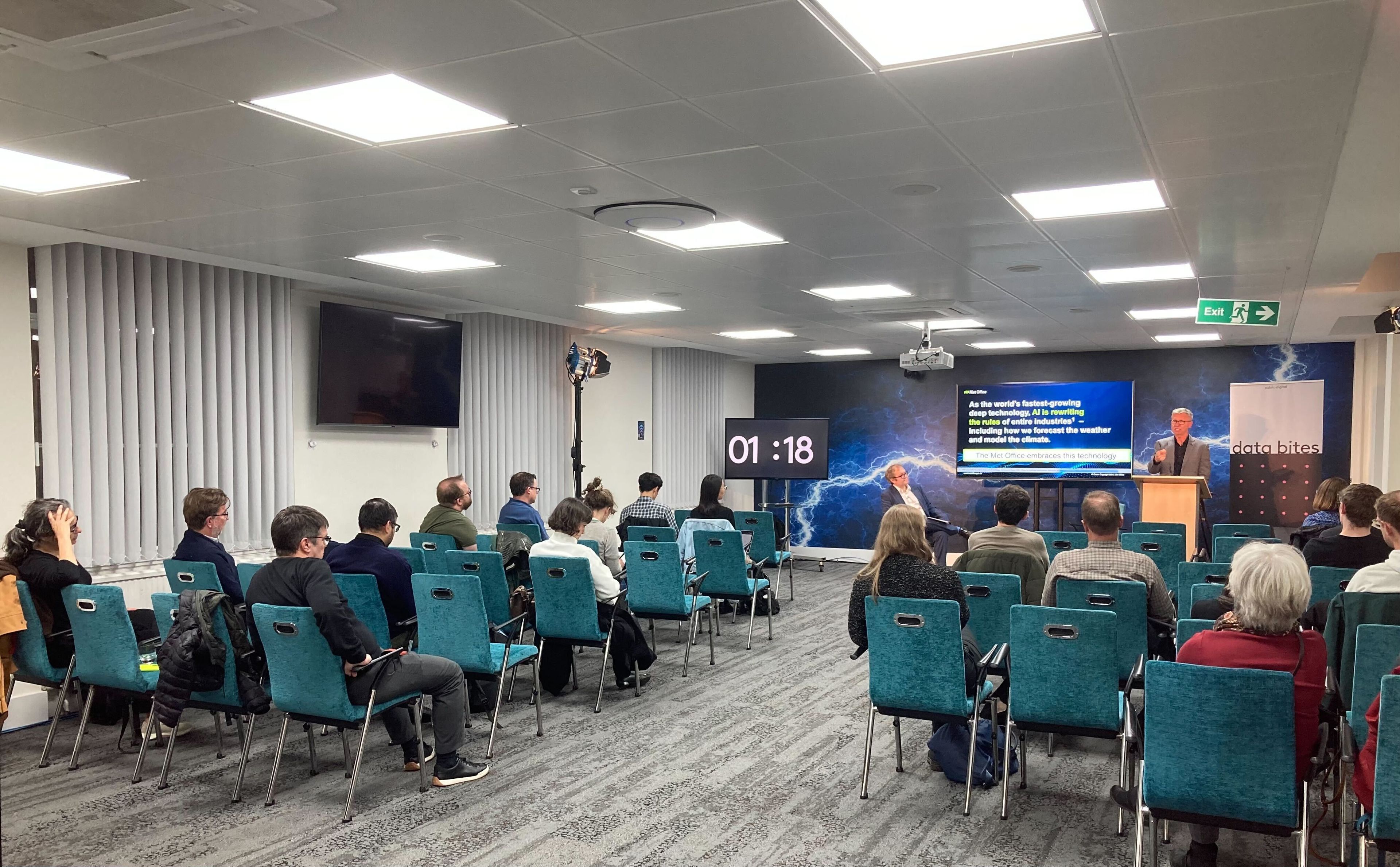Data Bites 59: The AI special
Data Bites has covered the many uses of many different forms of artificial intelligence since its very first event in April 2019, but October 2025 was our first ever AI special. Our speakers covered everything from weather models, to participation and children’s rights, to vibe coding, to internal insight tools for staff.

If you’ve not been (or seen) before: Data Bites is a monthly event showcasing how data is used in and around the public sector. Four speakers get eight minutes to present – there are eight bits in a byte, hence eight minutes in a Data Bite – followed by eight minutes of audience questions. October’s event was the tenth Data Bites hosted by Public Digital, after 49 events at the Institute for Government.
You can now sign up in person or online for the next Data Bites on Tuesday 18 November, where speakers include the chief statistician at the Welsh Government and presenters from the Greater London Authority, Office for National Statistics and Office for Statistics Regulation.
Watch the recording of the event below, and access summary and links to presentations.
Simon McLellan on big data and AI opportunities at the Met Office
Simon McLellan, Head of Data Engagement at the Met Office (who previously presented at Data Bites in July 2022), gave us an overview of where the Met Office is using AI in its work. This includes in the organisation’s weather forecasting work, using AI models to complement existing physical ones.
You can see more in Simon’s slides, or in his answers to our standard set of questions below:
Can you summarise your project in a few sentences?
We’re exploring how AI and ML can help improve the accuracy of weather prediction, and help provide meaningful user-focussed insight from dynamic, complex, scientific data
What problem are you trying to solve?
Our big data challenge where the volume, velocity and wide variety of global, spatiotemporal weather and climate data mean that it is unrealistic, unaffordable and not really possible to distribute our highest-resolution datasets within a useful timeframe in the ways we’ve done so up to this point. We’re exploring how AI/ML can help improve the accuracy and usefulness of weather and climate services.
What difference will it make to citizens?
Through innovation and agility we’re combining purposeful data and intelligence to deliver trusted impact-based services – what the weather will do, not just what the weather will be. These will help government, businesses and citizens make better decision to stay safe and thrive.
How will you know when it’s succeeded?
Our new Met Office Strategy has three priority areas that we’re working towards for 2030: Customer driven trusted services. Working with agility and innovation to deliver value and support growth through combining Purposeful data and intelligence to help you make better decisions to stay safe and thrive. We already measure the accuracy of our forecasts and public trust in our services. These and other measures on data availability and use will help us monitor our progress.
What are the main hurdles?
Data volumes are a big challenge, but the pace of change is a hurdle and an opportunity. Our world is radically changing - with increasingly frequent severe and extreme weather events, the changing climate, and new and emerging technologies like AI and ML.
If you could change one thing about data in government, what would it be?
It’s great that ‘data’ is becoming more visible and recognised as a ‘thing’ in government. We’re working to make data accessible/interoperable between IT systems, but we also need to data accessible/understandable to people using those IT systems. I’m thinking about how to interpret data (eg probability of precipitation) and understand its limitations (eg the cone of uncertainty I talked about). Basically building data culture and data narratives.
Further links that might be of interest:
Steph Wright on exploring children’s rights and AI
Steph Wright, Head of the Scottish AI Alliance, discussed a recent project where the Alliance worked with 140 children from 6 schools across Scotland over 3 years to understand children’s thoughts and feelings on AI and its impacts on their lives and rights. She shared some of the findings (children are optimistic but also have real concerns), some of the resources (such as learning modules and lesson plans) and a video. You can find out more in Steph’s slides.
James Ancell on making data interactive with micro-applications
James Ancell, Head of Futures and Foresight at the Joint Data and Analysis Centre (Cabinet Office), gave us a tour of some of his experiments with spinning up interactive data visualisations and other applications using AI. These covered everything from network maps of Lord of the Rings to media monitoring.
Dr Lauren Petrie on GIAA’s engines
Dr Lauren Petrie, Head of Data Analytics at the Government Internal Audit Agency, talked us through some of the GIAA’s AI tools (or putting the AI into IA - internal audit). This included a demonstration of the organisation’s Risk Engine, to help analysts think about the potential risks raised by different organisations’ business objectives, and mentions of their Insights, Writing and Foresight Engines. (Lauren also presented more widely on the GIAA’s work with data and AI at TransformGov Talks, which PD sponsors, a week later.)
You can see Lauren's slides here.
Sign up in person or online for the next Data Bites on Tuesday 18 November.